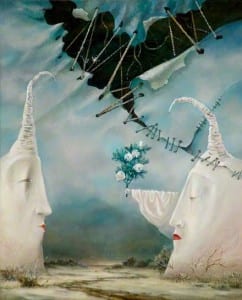After discussion we decided that we wanted to use another space in The Collection, the education room that looks out onto the Café. This was because we thought it would be good as it was an example of how the two buildings could be together yet they are apart. It was also another thing to do with our research and how children mimic what they see in society and in cafes. Children notice things that adults don’t. We decided it would be a good idea for some members of the group to have a tea party up in the education room, acting like children and using a child’s tea set. We experimented trying out lots of things whilst the rest of the group sat in the café and suggested to us afterwards what worked and didn’t work. Throughout this process we felt it was more natural for us to start as children but by the end become business women who were professional. Whilst we were doing this in the education room, the rest of the group aimed to create an exhibition down in the café and present all of the things that people might not notice but we had noticed over the past few weeks. After experimenting with this exhibition idea it was clear that it needed to be pushed even further as it just wasn’t working but again we had to take into account that it was still as business…
This was beginning to not seem a great place after all.
We showed our performance ideas so far to the rest of the groups and received great feedback for the tea party in the education room and got told things such as
“once you watch your intrigued that you need to keep watching to see what happens next”
“it’s a really good idea”
“it works well, maybe make more of it”
This was really positive for us as we wasn’t sure if it was going to make an impact or not. Most importantly we wasn’t sure if we could be seen clearly enough but it seemed to work ok, this wasn’t the same for the café however as the idea we hadn’t didn’t really work well and so needed to be rethought. As well as this exhibition we had the other three group members in the café talking to themselves using a verbatim script that had been creating through listening to peoples conversations. This seemed to get lost so we discussed our whole idea and decided to see what the effect would be if we took this outside. We weren’t sure if this would work as we were taking it out of its original setting, out of the café atmosphere and outside. So taking this outside and trying it out it felt like something was missing, it lacked energy and needed something to back it up. Still wanting to keep the education room idea we discussed whether there was a way that we could link outside and the education room. In the end it was suggested that maybe we could attempt to create our own exhibition outside and portraying our version of the important things in the café.
Our ideas included:
• Having the three people sat at their own individual table talking to themselves, one would portray ‘the reader’ another ‘the working man’ and the third would portray ‘the family man’ as these are the three characteristics that we picked up on most throughout our research.
• Taking pictures and creating a framed piece up on the wall of the café, and showing how it changes throughout the day.
• Having the sentences we had heard wrote in chalk down the stairs to create something different
• Using the placard idea from inside and seeing how that worked.
